Calycanthus
Calycanthus, called sweetshrub,[2][3] is a genus of flowering plants in the family Calycanthaceae, endemic to North America. The genus includes two to four species depending on taxonomic interpretation; two are accepted by the Flora of North America.
| Calycanthus | |
|---|---|
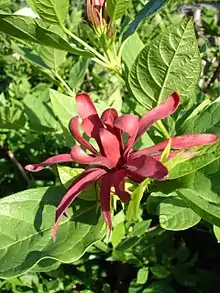 | |
| Calycanthus floridus | |
| Scientific classification | |
| Kingdom: | Plantae |
| Clade: | Tracheophytes |
| Clade: | Angiosperms |
| Clade: | Magnoliids |
| Order: | Laurales |
| Family: | Calycanthaceae |
| Genus: | Calycanthus L. |
| Species | |
| Synonyms[1] | |
|
List
| |
Description
Calycanthus plants are deciduous shrubs, growing 1–4 m (3.3–13.1 ft) tall and wide. The bright green leaves are opposite, entire, 5–15 cm (2.0–5.9 in) long and 2–6 cm (0.79–2.36 in) broad.
The bark has a strong camphor smell that is released when stems are scraped.[4] The smell remains strong on twigs that have been stored several years in a dry environment.
The strongly scented flowers are typical of the family Calycanthaceae in lacking distinct sepals and petals, but instead have distinct spirals of tepals. They are produced from late spring through early autumn for C. occidentalis, and April to July for C. floridus.[5] The flowers of these two species are 4–7 cm (1.6–2.8 in) broad, with numerous dark red to burgundy to purplish brown tepals. C. chinensis has broader tepals, the outer white flushed with pink, the inner mostly yellow with purple marks at the base.[6]
The lotus-shaped flowers can resemble a small magnolia flower. They are pollinated by beetles in the family Nitidulidae.[7]
The fruit is an elliptical dry capsule 5–7 cm long, containing numerous seeds.
Taxonomy
The genus Calycanthus was created by Carl Linnaeus in 1759,[8] with the sole species Calycanthus floridus.[9] In 1762, he added Calycanthus praecox, now treated as Chimonanthus praecox.[10]
Phylogeny and evolution
A 2006 molecular phylogenetic study of the family Calycanthaceae found that the three widely recognized species of Calycanthus formed a monophyletic group. Relationships among the three species differed depending on whether chloroplast or nuclear data was used. A cladogram obtained by combining the two is shown below.[11]
| Calycanthaceae |
| ||||||||||||||||||||||||
The family Calycanthaceae may have had a Gondwanan origin. The sole Australian representative, Idiospermum australiense, would then represent an ancient relic, probably having diverged in the Cretaceous. There are no extant South American members of the family, although fossils are known. Calycanthus may have migrated into North America from eastern Asia, or may have originated in South America, moved northwards and then spread to eastern Asia.[11]
Species
As of February 2020, Plants of the World Online accepted four species:[12]
- Calycanthus brockianus Ferry & Ferry f.—north central Georgia; has greenish rather than brownish red flowers, and may only be a triploid color variant of C. floridus.[6]
- Calycanthus chinensis (W.C.Cheng & S.Y.Chang) W.C.Cheng & S.Y.Chang ex P.T.Li (syn. Sinocalycanthus sinensis)—Chinese sweetshrub, Chinese wax shrub, native to eastern China, with white flowers[13]
- Calycanthus floridus L.—Carolina spicebush, eastern sweetshrub, native to the Eastern United States, from New York and Missouri, south through the Appalachian Mountains, Piedmont, and Mississippi Valley, to Louisiana, and east to northern Florida[14]
- Calycanthus occidentalis Hook. & Arn.—California spicebush, western sweetshrub, native to moist habitats of California below 1,500 m (4,900 ft), including in the California Coast Ranges, San Joaquin Valley, and Sierra Nevada.[17][18] The Oregon Flora Project documents one specimen in Oregon.[19]
C. chinensis has a confused taxonomic history. It was first described in 1963 as Calycanthus chinensis by W.C. Cheng and S.Y. Chang, but invalidly because two different collections were both given as holotypes. The authors then described it validly in 1964 in their new genus Sinocalycanthus. In 1979, P.T. Li rejected the genus Sinocalycanthus, and validated the original name Calycanthus chinensis.[6]
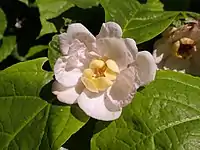 C. chinensis–Chinese sweetshrub
C. chinensis–Chinese sweetshrub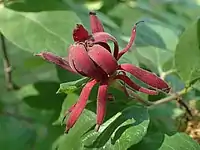 C. floridus—eastern sweetshrub
C. floridus—eastern sweetshrub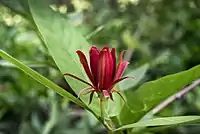 C. occidentalis—western sweetshrub
C. occidentalis—western sweetshrub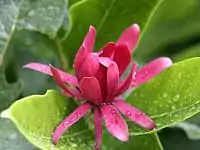 C. occidentalis—western sweetshrub
C. occidentalis—western sweetshrub
Uses
Medicinal plant
Calycanthus floridus and C. occidentalis were both used as a traditional medicinal plant by Native Americans. The indigenous peoples of California also used C. occidentalis in basketweaving and for arrow shafts.[20] [21]
Cultivation
Calycanthus species are cultivated as ornamental plants by plant nurseries, including in the United States and England.
Calycanthus occidentalis is planted in traditional, native plant, and wildlife gardens, and for natural landscaping and habitat restoration projects, primarily in California and the Western United States.[5][7][22][23] It was introduced into cultivation in 1831.[5]
Calycanthus floridus is also planted in gardens, as a specimen shrub, or for hedges.[24][25] The cultivar C. × raulstonii 'Hartlage Wine' has gained the Royal Horticultural Society's Award of Garden Merit.[26]
Mark Catesby found it in the Piedmont woodlands of the British Province of Carolina in 1732. He described it, with its bark "as odoriferous as cinnamon", but did not name it.[27] The colonial planters of the Carolinas transplanted it into their gardens, and the botanist Peter Collinson described it to Linnaeus and imported it into England from Charleston in the Province of South Carolina around 1756.[28]
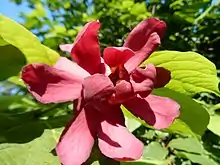
Several hybrids and cultivars have been produced. The hybrid between C. chinesis and C. floridus has been named C. × raulstonii. It combines the larger flowers of C. chinesis with the flower color of C. floridus. The original cross has been given the cultivar name 'Hartlage Wine' after the student, Richard Hartlage, who made the first crosses. Further crosses have been made. 'Venus' involves C. occidentalis as well.[6]
Essential oils
Calycanthus oil, distilled from the flowers, is an essential oil used in some quality perfumes.[29] The flowers of C. occidentalis have a spicy, sweet scent. The flowers of C. floridus were compared to a bubble-gum scent by one reference.[30]
References
- "Calycanthus L." Plants of the World Online. Board of Trustees of the Royal Botanic Gardens, Kew. 2017. Retrieved 24 September 2020.
- Flora of North America: Calycanthus
- USDA Plants Profile: Calycanthus
- Calycanthus floridus. from Plants for a Future
- Lady Bird Johnson Wildflower Center Native Plant Information Network-NPIN: Calycanthus occidentalis (Western spicebush)
- Lancaster, Roy & Rix, Martyn (2019). "921. Calycanthus chinensis Calycanthaceae". Curtis's Botanical Magazine. 36 (4): 340–346. doi:10.1111/curt.12302.
- Las Pilitas Horticulture database: Spice Bush−Calycanthus occidentalis
- "Calycanthus L." International Plant Names Index (IPNI). Royal Botanic Gardens, Kew. Retrieved 2021-02-06.
- Linnaeus, C. (1759). Systema Naturae. Vol. 2 (10th ed.). Stockholm (Holmia): Laurentius Salvius. p. 1066.
- "Calycanthus praecox L." Plants of the World Online. Royal Botanic Gardens, Kew. Retrieved 2021-02-06.
- Zhou, S.; Renner, S. & Wen, J. (2006). "Molecular phylogeny and intra- and intercontinental biogeography of Calycanthaceae" (PDF). Molecular Phylogenetics and Evolution. 39: 1–15. doi:10.1016/j.ympev.2006.01.015.
- "Calycanthus L." Plants of the World Online. Royal Botanic Gardens, Kew. Retrieved 2021-02-05.
- "Calycanthus chinensis (W.C.Cheng & S.Y.Chang) W.C.Cheng & S.Y.Chang ex P.T.Li". Plants of the World Online. Royal Botanic Gardens, Kew. Retrieved 2021-02-05.
- USDA: Calycanthus floridus distribution map
- USDA: Calycanthus floridus var. floridus
- USDA: Calycanthus floridus var. glaucus
- Jepson Manual (TJM93) treatment of Calycanthus occidentalis
- USDA Calycanthus occidentalis distribution map
- University of Michigan at Dearborn, Native American Ethnobotany database: Calycanthus floridus (California spicebush)
- University of Michigan at Dearborn, Native American Ethnobotany database: Calycanthus occidentalis (Carolina allspice)
- "Theodore Payne Foundation, California Native Plant Horticulture database: Calycanthus occidentalis - Spice Bush". Archived from the original on 2015-06-12. Retrieved 2015-06-11.
- Missouri Botanical Garden, Garden Help: Calycanthus occidentalis
- Lady Bird Johnson Wildflower Center Native Plant Information Network-NPIN: Calycanthus floridus (Eastern spicebush)
- Missouri Botanical Garden, Garden Help: Calycanthus floridus
- "Calycanthus × raulstonii 'Hartlage Wine'". RHS. Retrieved 12 April 2020.
- Catesby, The Natural History of Carolina (1732).
- Coats (1964) 1992.
- Groom, N. The New Perfume Handbook, second ed., Springer, 1997, page 48.
- iVillage Garden Web: "Which shrubs smell good list"
Bibliography
- Hsu, Eric (March 2018). "An overview of Calycanthus". The Plantsman (New Series). 17 (1): 32–39.
External links
| Wikimedia Commons has media related to Calycanthus. |